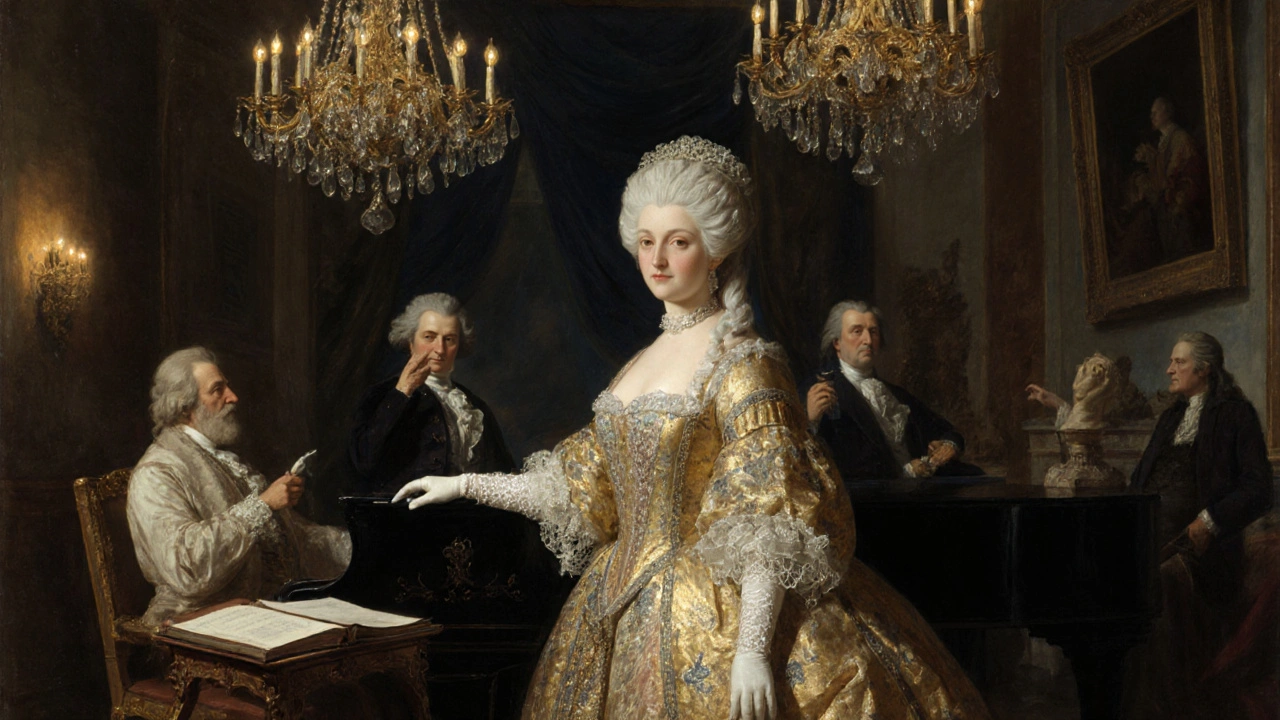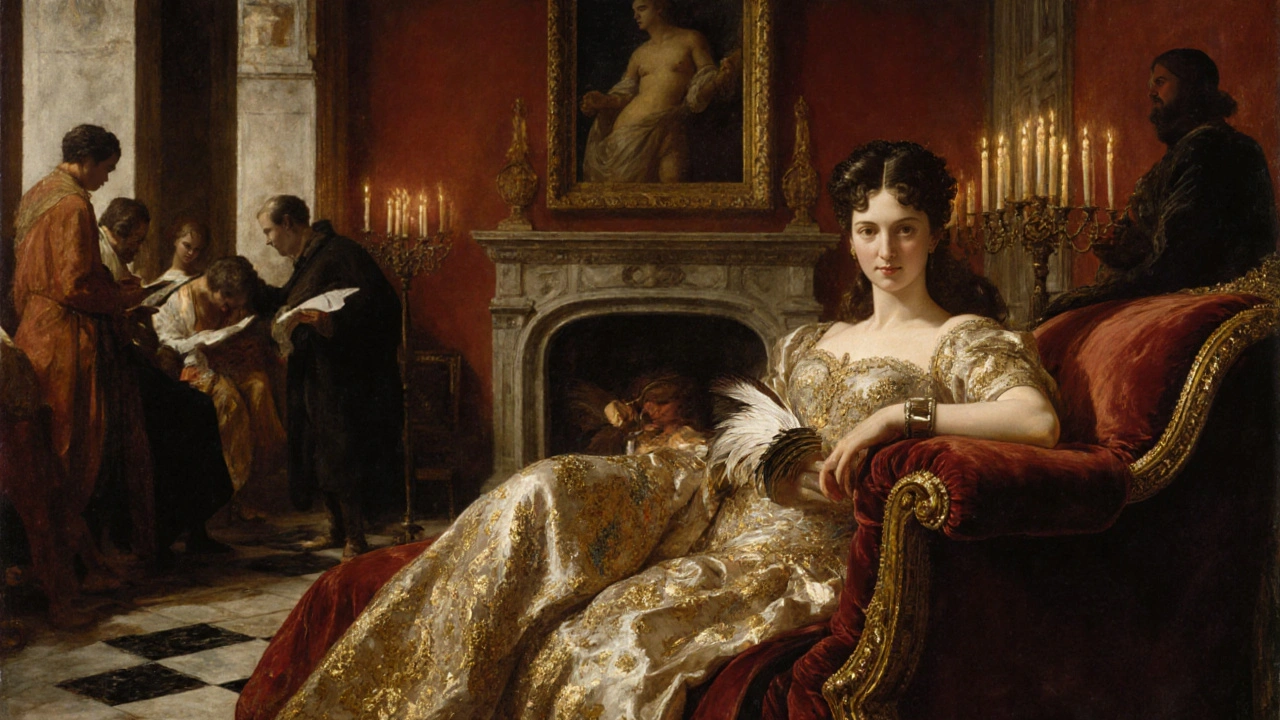You’ve seen the paintings: women in silk gowns, holding fans like weapons, gazing out with eyes that know too much. They weren’t queens. They weren’t wives. But in places like 16th-century Venice, 18th-century Paris, or Edo-period Tokyo, they held more power than most nobles. These were courtesans-women who traded intellect, charm, and artistry for wealth and influence. And their impact on the world’s art, music, and culture? It’s still echoing today.
What Exactly Was a Courtesan?
A courtesan wasn’t just a high-end sex worker. That’s the myth. The real truth? A courtesan was a professional companion-part philosopher, part performer, part social strategist. She was educated in literature, music, dance, and politics. She could debate theology with a bishop, improvise a sonnet, and outmaneuver a duke in a card game-all while wearing a dress worth a farmer’s annual income.
In Renaissance Italy, courtesans like Veronica Franco weren’t hidden away. They hosted salons where artists, poets, and thinkers gathered. In Japan, oiran were trained for years in tea ceremony, calligraphy, and the 36 poetic forms of waka. In France, the Marquise de Pompadour didn’t just sleep with Louis XV-she shaped his taste in furniture, commissioned paintings, and influenced foreign policy.
They weren’t passive objects. They were curators of culture. And when they died, their legacies didn’t vanish. They lived on in the brushstrokes of Titian, the melodies of Vivaldi, and the silhouettes of 18th-century fashion.
Why Courtesans Mattered in Art
Think about the most famous female portraits in Western art. Who are they? Mona Lisa? Venus? Look closer. Many were modeled after courtesans.
Titian’s Venus of Urbino (1538) wasn’t painted to honor a goddess. It was commissioned by a nobleman to celebrate his courtesan lover, Emilia Pia. The pose? Relaxed, intimate, owning the space. The dog at her feet? Symbol of fidelity. The flowers? Fertility. The direct gaze? A challenge to the viewer. This wasn’t myth-it was real life, elevated to high art.
In France, Fragonard painted courtesans lounging in velvet, their hair loose, their expressions knowing. These weren’t scandalous images-they were aspirational. The wealthy wanted to be seen with women who had taste, wit, and poise. So artists painted them. And in doing so, they turned courtesans into icons of beauty and sophistication.
Even in Japan, ukiyo-e prints of courtesans weren’t just erotic. They were fashion catalogs. The way the obi was tied, the pattern on the kimono, the hairstyle with its dozens of hairpins-each detail was copied by women across Edo. Courtesans didn’t follow trends. They created them.
The Music, Poetry, and Theater They Inspired
Music thrived in their salons. In Venice, courtesans hired composers to write new pieces just for their gatherings. Vivaldi’s operas? Often premiered at courtesan-hosted events. Their voices, trained from childhood, became the gold standard for vocal technique.
In China, courtesans were the only women allowed to perform publicly in Ming Dynasty theaters. They wrote poetry that rivaled the scholars’. One courtesan, Li Xiangjun, penned verses so powerful they were later included in imperial anthologies. Her story became the basis for the classic play The Peach Blossom Fan, still performed today.
And then there’s the French salon culture. Women like Madame Geoffrin didn’t just host dinners-they shaped the Enlightenment. Voltaire, Diderot, Rousseau? They came because she offered wine, wit, and a space where ideas could grow without censorship. Her salon became the unofficial academy of revolutionary thought.
How Courtesans Changed Fashion
Want to know why 18th-century women wore powdered wigs and silk slippers? Thank the courtesans.
When Marie Antoinette was still a young queen, she copied the hairstyles of her favorite courtesan, Madame du Barry. The towering, feathered wigs? First worn by courtesans to outshine aristocrats. The lace gloves? Designed to hide the fact that they worked with their hands. The corsets? Tighter than ever, because courtesans knew a narrow waist made you look more desirable-and more dangerous.
In Japan, the oiran’s kimono patterns were so intricate, they took months to weave. Each design told a story: cherry blossoms for fleeting beauty, cranes for longevity. Commoners couldn’t afford them-but they copied the styles anyway. The result? A trickle-down effect that reshaped Japanese fashion for generations.
Even today, when you see a runway show with exaggerated silhouettes or dramatic makeup, you’re seeing the ghost of a courtesan who dared to stand out.

Where Did Courtesans Operate? A Global Snapshot
- Italy (1500-1700): Venice and Florence were hubs. Courtesans like Veronica Franco published poetry and sued nobles for defamation-winning.
- France (1600-1800): Parisian courtesans lived in luxury apartments on the Rue Saint-Honoré. Many became patrons of the arts, funding painters and sculptors.
- Japan (1600-1868): The Yoshiwara district in Edo (Tokyo) housed thousands of courtesans. The highest rank, oiran, were treated like royalty.
- China (1500-1900): In Nanjing and Hangzhou, courtesans were part of elite literary circles. Some even owned land and businesses.
- India (1700-1900): Tawaifs in Lucknow and Delhi were masters of classical dance and music. They trained future Bollywood stars and preserved ragas that might have been lost.
Each culture had its own rules, but the pattern was the same: courtesans were the only women allowed to be publicly brilliant.
How They Gained Power Without a Title
They had no noble blood. No inheritance. No legal rights. So how did they control so much?
They used what they had: intelligence, charm, and networks. A courtesan didn’t need to marry a duke to influence him. She just needed to make him feel understood. She listened better than his wife. She remembered his favorite wine. She quoted his favorite poet before he did.
Many courtesans saved their earnings and bought property. Some funded schools. Others became lenders to kings. In 17th-century Venice, courtesans owned over 30% of the city’s luxury textile trade. In China, some became landowners after their patrons died.
They weren’t just surviving. They were building empires-quietly, elegantly, and with full control.
Why Their Legacy Still Matters Today
Think about modern influencers. The ones who don’t just sell products, but lifestyles. Who turn personal style into global trends. Who have more cultural sway than politicians.
That’s the courtesan’s descendant.
Today’s fashion models, podcast hosts, and social media stars? They’re doing the same thing: trading authenticity, aesthetics, and emotional intelligence for influence. The tools changed-Instagram replaced the salon, TikTok replaced the opera-but the mechanism? Identical.
And just like courtesans, modern influencers face the same double standard: praised for their beauty, dismissed for their brains. Yet their impact? Unmistakable.
When you see a woman on a billboard wearing a dress designed by a female fashion house, or hear a pop song written by a woman who refused to be silenced-you’re seeing the legacy of the courtesan. She didn’t wait for permission. She created her own space. And she made sure the world noticed.

What Happened to Courtesans?
They didn’t disappear. They were erased.
By the 19th century, industrialization, religious reform, and rising middle-class morality labeled courtesans as immoral. Laws criminalized their work. Salons closed. Artworks were destroyed. History books called them “fallen women.”
But the art they inspired? The music they commissioned? The fashion they invented? Those stayed. And so did their quiet rebellion.
Today, historians are digging through archives, translating forgotten poems, and restoring their portraits. Museums in Venice and Kyoto now display courtesan artifacts-not as curiosities, but as cultural pioneers.
They weren’t victims. They weren’t villains. They were women who turned limitation into leverage. And in doing so, they changed the world.
FAQ: Your Questions About Courtesans Answered
Were courtesans the same as prostitutes?
No. While some courtesans did engage in sexual relationships, their primary value was intellectual and cultural. They were trained in music, poetry, and etiquette, and often served as companions to wealthy men, hosting salons and influencing art and politics. A prostitute, by contrast, typically offered only physical services without the same level of education or social access.
Did courtesans have any legal rights?
In most societies, courtesans had few legal rights. But in places like Venice and Edo-period Japan, some gained protection through contracts or guilds. In Venice, courtesans could sue for defamation or breach of contract. In Japan, top courtesans had formal licenses and could own property. Their power came from influence, not law.
How did courtesans become so wealthy?
They earned money through patronage, gifts, and fees for companionship. Wealthy men paid for their time, their artistry, and their connections. Many saved their earnings and invested in real estate, textiles, or businesses. Some courtesans became lenders, landlords, or even art collectors.
Are there modern equivalents to courtesans?
Yes. Modern influencers, high-end escorts who offer intellectual companionship, and cultural tastemakers in fashion or media carry the same legacy. They use personal brand, charm, and aesthetic control to gain influence, often bypassing traditional power structures. Think of a socialite who shapes trends or a celebrity curator who launches brands-these are the 21st-century courtesans.
Why are courtesans rarely taught in history classes?
Because history was written by men in power who wanted to erase women who operated outside traditional roles. Courtesans challenged gender norms, controlled their own finances, and influenced politics without titles. That made them dangerous to the narrative. Only recently have historians begun to recover their stories.
Final Thought: The Quiet Revolution
They didn’t march. They didn’t protest. They didn’t demand rights. They simply showed up-brilliant, beautiful, and unapologetic-and made the world bend to their rhythm.
Next time you see a painting of a woman who looks like she owns the room, remember: she might not be a goddess. She might be a courtesan. And she’s still speaking to you-through the brush, the note, the stitch, the silhouette.

